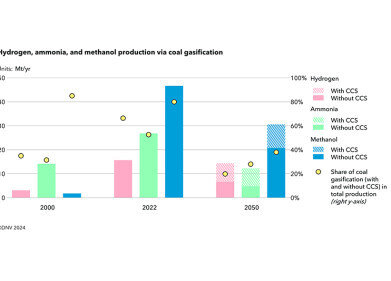-
 Delta, Utah
Delta, Utah -
 Great Salt Lake, Utah
Great Salt Lake, Utah -
 Hornsea beach on the East Yorkshire coast
Hornsea beach on the East Yorkshire coast
Green Energy
The feasibility of underground hydrogen storage in salt caverns
Aug 12 2021
Author credit – Stephen B. Harrison, Allegra Cresswell-Turner and S. Hamid Yousefi, sbh4 consulting
There are different methods for energy storage based on the storage time and energy deliverability such as batteries, flywheels, thermal energy storage, compressed air energy storage, pumped hydro, and hydrogen. The optimum method depends on the storage duration, energy release rate and storage capacity. To add flexibility to integrated energy systems, long term, high-capacity energy storage will be essential to balance seasonal variations in energy supply and demand. A technology known as Underground Hydrogen Storage, or UHS is ideal for this application.
UHS technology and case studies
Salt caverns are man-made cavities in salt deposits below ground. They are created using a technique called ‘solution mining’. During this process, water is injected into the underground salt layer to dissolve the rock salt gradually. The generated brine is extracted from the well and can either be used for industrial or commercial applications, or must be carefully disposed of in the ocean or nearby salt-lake. When the cavern reaches the designed volume, gas is injected into the cavern to displace the residual brine.
The salt cavern is then pressurised to its working pressure, which may be between 150 and 200 bar. The total gas injected into the salt caverns cannot be recovered in withdrawal cycles because a residual pressure of about 50 bar is required inside the salt cavern to strengthen it. This pressurised ‘cushion gas’ acts like air inside a balloon, retaining its firm round shape.
Salt caverns are generally located at a depth of between 500 and 2,000m below the sea level, with an internal volume in the range of 100,000 to 1,000,000m3. They are typically 200m high and have a diameter of 50m. The amount of gas that that can be injected and withdrawn in each cycle is called ‘working gas’. The total gas storage volume is therefore comprised of cushion gas and working gas, typically, 30% of the total gas is used for cushion gas in salt caverns.
Currently, two UHS pilots are planned in Germany and Netherlands in 2021-2022. A larger project in Utah, USA is also in development. This scheme involves Mitsubishi Hitachi Power Systems (MHPS) and Magnum Development, who intend to create a massive green hydrogen storage hub close to the town of Delta by 2025. They will use more than 1GW of electrolysers to produce hydrogen and store it in 100 huge underground salt caverns for seasonal energy demand balancing.
The role of UHS in energy system integration
The North Sea and its nearby onshore region could also be an attractive choice for energy system integration, where CO2 could be injected into oil and gas reservoirs and aquifers to generate blue hydrogen from local natural gas resources. Offshore wind power generation is being installed at GW scale, enabling green hydrogen production. The green and blue hydrogen can be stored in multiple UHS salt caverns, thereby fully harnessing natural resources above and below the ground in the region. The North Sea Energy program and the Zero Carbon Humber project are planning to use this region capability for sustainable energy system.
The main elements for economic analysis of UHS in salt caverns are geological construction, cushion gas investment, surface facility design (compressor and dehydration unit) and the initial cost of drilling wells and bride disposal. CAPEX can be in the order of €50-100 million per cavern and when also considering and OPEX costs during the lifetime of the operation, the levelized cost of storage can be expected to be in the region of €1-2 per kg of stored hydrogen.
Overall, salt caverns are suitable choices for large-scale, long-term hydrogen storage as they can add flexibility to the electrical grid on daily basis, as well as offering seasonal energy storage in an integrated energy system.
Events
May 13 2024 Munich, Germany
May 23 2024 Beijing, China
May 23 2024 Beijing, China
Jun 10 2024 Algiers, Algeria
Jun 10 2024 Frankfurt, Germany













